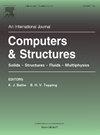基于加权最小二乘的光滑框架提高稳定节点光滑有限元法(SNS-FEM)位移精度
IF 4.8
2区 工程技术
Q1 COMPUTER SCIENCE, INTERDISCIPLINARY APPLICATIONS
引用次数: 0
摘要
基于节点的光滑有限元方法(NS-FEM)通过采用平均节点应变和节点积分来构建刚度矩阵,减轻了标准有限元方法(FEM)中的应变和体积锁定问题。然而,节点积分可能无法约束某些畸变模式,导致数值不稳定。稳定NS-FEM (SNS-FEM)引入临时积分点来约束这些伪模态,从而恢复稳定性。本文提出了一种新的计算公式,提高了网络有限元法的位移精度,特别是在粗网格上。该方法采用加权最小二乘(WLS)方法计算节点应变,而不是依赖局部应变积分和平均。利用WLS的灵活性,有策略地选择应变采样位置和多项式拟合阶数来修改计算得到的节点应变梯度。与SNS-FEM相比,这种修正使得稳定项的刚度贡献更小,从而提高了位移精度。该配方通过四种类型的测试案例进行评估,主要关注位移场和固有频率模式。结果表明,该方法在保持动态稳定性的同时,提高了相对于sns - fem的位移精度,特别是在粗网格上,计算成本相当。本文章由计算机程序翻译,如有差异,请以英文原文为准。
Enhancing displacement accuracy of stable node-based smoothed finite element method (SNS-FEM) with a smoothing framework based on weighted least squares (WLS)
The Node-based Smoothed Finite Element Method (NS-FEM) mitigates strain and volumetric locking in the standard Finite Element Method (FEM) by employing averaged nodal strains and nodal integration to construct the stiffness matrix. However, nodal integration may fail to constrain certain distortion modes, resulting in numerical instability. Stable NS-FEM (SNS-FEM) introduces temporary integration points that constrain these spurious modes, restoring stability. This paper proposes a new formulation that enhances the displacement accuracy of SNS-FEM, particularly on coarse meshes. Instead of relying on local strain integration and averaging, the method computes nodal strains using a Weighted Least Squares (WLS) approach. By leveraging the flexibility of WLS, it strategically selects strain sampling locations and polynomial fitting orders to modify the computed nodal strain gradients. Compared to SNS-FEM, this modification leads to a lower stiffness contribution from the stabilisation term, thereby improving displacement accuracy. The formulation is evaluated across four types of test cases, focusing primarily on displacement fields and natural frequency modes. Results demonstrate that the proposed method preserves dynamic stability while improving displacement accuracy relative to SNS-FEM—especially on coarse meshes—at comparable computational costs.
求助全文
通过发布文献求助,成功后即可免费获取论文全文。
去求助
来源期刊

Computers & Structures
工程技术-工程:土木
CiteScore
8.80
自引率
6.40%
发文量
122
审稿时长
33 days
期刊介绍:
Computers & Structures publishes advances in the development and use of computational methods for the solution of problems in engineering and the sciences. The range of appropriate contributions is wide, and includes papers on establishing appropriate mathematical models and their numerical solution in all areas of mechanics. The journal also includes articles that present a substantial review of a field in the topics of the journal.
 求助内容:
求助内容: 应助结果提醒方式:
应助结果提醒方式:


